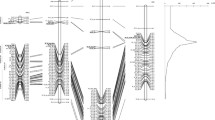Abstract
Gametophytic apomixis in Kentucky bluegrass (Poa pratensis L.) involves the parthenogenetic development of unreduced eggs from aposporic embryo sacs. Marker-assisted selection for the mode of reproduction in P. pratensis would avoid costly and time-consuming phenotypic progeny tests. We developed and tested two SCAR primer pairs that are associated with the mode of reproduction in P. pratensis. The SCAR primers identified the apomictic and sexual genotypes among progenies of sexual x apomictic crosses with very low bias. Furthermore, when tested on a wide range of Italian and exotic P. pratensis germplasm, they were able to unequivocally distinguish sexual from apomictic genotypes. This system should, therefore, allow new selection models to be set up in this species.
Similar content being viewed by others
References
Barcaccia G., Mazzucato A., Belardinelli A., Pezzotti M., Lucretti S. and Falcinelli M. 1997. Inheritance of parental genomes in progenies of Poa pratensis L. from sexual and apomictic genotypes as assessed by RAPD markers and flow cytometry. Theor. Appl. Genet. 95: 516–524.
Barcaccia G., Mazzucato A., Albertini E., Zethof J., Pezzotti M., Gerats A. and Falcinelli M. 1998. Inheritance of parthenogenesis in Poa pratensis L.: auxin test and AFLP linkage analyses support monogenic control. Theor. Appl. Genet. 97: 74–82.
Barcaccia G., Mazzucato A. and Falcinelli M. 2000. Inheritance of apomictic seed production in Kentucky bluegrass (Poa pratensis L.). J New Seeds 2(1): 43–58.
Clausen J. 1961. Introgression facilitated by apomixis in polyploids poas. Euphytica 10: 87–94.
Mazzucato A., Falcinelli M. and Veronesi F. 1996b. Evolution and adaptedness in a facultatively apomictic grass, Poa pratensis L. Euphytica 92: 13–19.
Grazi F., Umaerus M. and Åkerberg E. 1961. Observations on the mode of reproduction and the embryology of Poa pratensis. Hereditas 47: 489–541.
Gustine D.L., Sherwood R.T. and Huff D.R. 1997. Apospory-linked molecular markers in buffelgrass. Crop Sci. 37: 947–951.
Klimyuk V.I., Carroll B.J., Thomas C.M. and Jones J.D.G. 1993. Alkali treatment for rapid preparation of plant material for reliable PCR analysis. Plant J. 3: 493–494.
Koltunow A.M. 1993. Apomixis: embryo sacs and embryos formed without meiosis or fertilization in ovules. Plant Cell 5: 1425–1437.
Kosambi D.D. 1944. The estimation of map distances from recombination values. Ann. Eugen. 12: 172–177.
Leblanc O., Grimanelli D., Gonzales de Leon D. and Savidan Y. 1995. Detection of the apomictic mode of reproduction in maize-Tripsacum hybrids using maize RFLP markers. Theor. Appl. Genet. 90: 1198–1203.
Matzk F. 1991. New efforts to overcome apomixis in Poa pratensis L. Euphytica 55: 65–72.
Mazzucato A. 1995. Italian germplasm of Poa pratensis L. II. Isozyme progeny test to characterize genotypes for their mode of reproduction. J. Genet. Breed. 49: 119–126.
Mazzucato A., Barcaccia G., Pezzotti M. and Falcinelli M. 1995. Biochemical and molecular markers for investigating the mode of reproduction in the facultative apomict Poa pratensis L. Sex. Plant Reprod. 8: 133–138.
Mazzucato A., den Nijs A.P.M. and Falcinelli M. 1996a. Estimation of parthenogenesis frequency in Kentucky bluegrass with auxininduced parthenocarpic seeds. Crop Sci. 36: 9–16.
Wedim W.F. and Huff D.R. 1996. Bluegrasses. In Bartels J.M., Peterson G.A., Baenziger P.S. and Bingham J.M. (eds.), Cool-Season Forage Grasses. American Society of Agronomy, Madison, WI, pp. 665–690.
Nogler G.A. 1984. Gametophytic apomixis. In: Johri B.M. (ed.), Embriology of Angiosperms, Springer-Verlag, New York, pp. 475–518.
Ozias-Akins P., Lubbers E.L., Hanna W.W. and McNay J.W. 1997. Transmission of the apomictic mode of reproduction in Pennisetum: co-inheritance of the trait and molecular markers. Theor. Appl. Genet. 85: 632–638.
Ozias-Akins P., Roche D. and Hanna W.W. 1998. Tight clustering and hemizygosity of apomixis-linked molecular markers in Pennisetum squamulatum implies genetic control of apospory by a divergent locus that may have no allelic form in sexual genotypes. Proc. Natl. Acad. Sci. USA 96: 5127–5132.
Paran I. and Michelmore R.W. 1993. Development of PCR-based markers linked to downy mildew resistance genes in lettuce. Theor. Appl. Genet. 85: 985–993.
Pessino S.C., Ortiz J.P.A., Leblanc O., do Valle C.B., Evans C. and Hayward M.D. 1997. Identification of a maize linkage group related to apomixis in Brachiaria. Theor. Appl. Genet. 94: 439–444.
Roche D., Peisheng C., Zhenbang C., Hanna W.W., Gustine D.L., Sherwood R.T. and Ozias-Akins P. 1999. An apospory-specific genomic region is conserved between buffelgrass (Cenchrus ciliaris L.) and Pennisetum squamulatum Fresen. Plant J. 19: 203–208.
Savidan Y. 1983. Genetics and utilization of apomixis for the improvement of guinea grass (Panicum maximum Jacq.). In: Smith J.A. and Hays V.W. (eds.), Proceedings of the XIV International Grassland Congress, (Lexington, KY), pp. 182–184.
Savidan Y. 1990. The genetic control of apomixis. Apomixis Newsl. 2: 24–26.
Smith S. and Beavis W. 1996. Molecular marker-assisted breeding in a company environment. In: Sobral B.W.S. (ed.), The Impact of Plant Molecular Genetics, Birkhäuser, Boston, MA, pp. 259–272.
Stam P. and Van Ooijen J.W. 1995. JoinMap TM version 2.0: software for the calculation of genetic linkage maps. CPRO-DLO, Wageningen, Netherlands.
van Wijk A.J.P. 1997. Breeding amenity grasses: achievements and future prospects. In: Staszewski Z., Mlyniec W. and Osinski R. (eds.), Ecological Aspects of Breeding Fodder Crops and Amenity Grasses. Plant Breeding and Acclimatization Institute, Radzikow, Poland, pp. 225–234.
Author information
Authors and Affiliations
Rights and permissions
About this article
Cite this article
Albertini, E., Barcaccia, G., Porceddu, A. et al. Mode of reproduction is detected by Parth1 and Sex1 SCAR markers in a wide range of facultative apomictic Kentucky bluegrass varieties. Molecular Breeding 7, 293–300 (2001). https://doi.org/10.1023/A:1011673112747
Issue Date:
DOI: https://doi.org/10.1023/A:1011673112747




